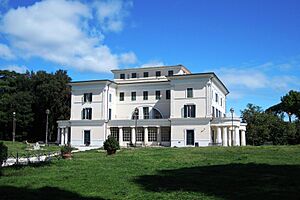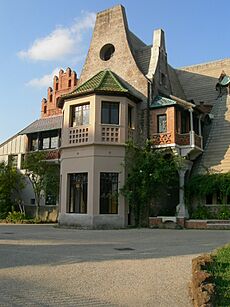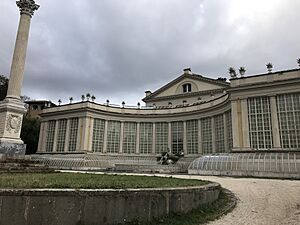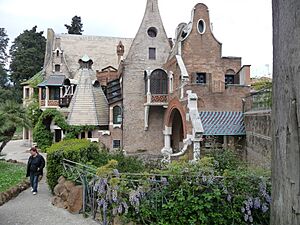Villa Torlonia (Rome) facts for kids
Quick facts for kids Villa Torlonia |
|
|---|---|
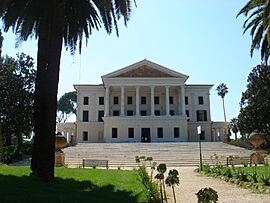
Villa Torlonia
|
|
| General information | |
| Town or city | Rome |
| Country | Italy |
| Coordinates | Lua error in Module:Coordinates at line 614: attempt to index field 'wikibase' (a nil value). |
| Design and construction | |
| Architect | Giuseppe Valadier |
Villa Torlonia is a beautiful old villa and its large gardens located in Rome, Italy. It used to belong to a wealthy family called the Torlonias. You can find its entrance on a street called via Nomentana. Today, it is a public museum and park that many people enjoy visiting.
Contents
How Villa Torlonia Was Designed
The famous Neoclassical architect Giuseppe Valadier designed Villa Torlonia. Construction started in 1806 for a rich banker named Giovanni Torlonia. His son, Alessandro, finished the work later.
A Look Back at Villa Torlonia's History
From the 1920s, Benito Mussolini, who was Italy's leader at the time, rented the villa from the Torlonia family. He paid only one lira a year to use it as his official home. He and his family lived there for 18 years.
After 1945, the villa was left empty and started to fall apart. However, in recent years, a lot of restoration work has been done. Now, the villa is a museum run by the city of Rome, and it is open for everyone to visit.
Exploring the Buildings and Gardens
Between 1802 and 1806, Valadier changed the main building into a grand palace. He also designed the park with neat, straight paths around the palace. Many classical artworks, especially sculptures, were bought to decorate the palace.
After Giovanni passed away, Alessandro hired the artist and architect Giovan Battisti Caretti in 1832. Caretti helped make the property even bigger. He built several new structures in the park, like the False Ruins, the Temple of Saturn, and the Tribuna con Fontana.
Alessandro also brought in other experts for different projects. Quintiliano Raimondi worked on the theatre and the orangerie, which is now called the “Lemon-house.” Giuseppe Jappelli was in charge of the entire southern part of the grounds. He created winding paths, small lakes, and planted unusual, exotic plants. He also added unique buildings like the Swiss Hut, which later became the Casina delle Civette. Other additions included the Conservatory, the Tower, the Moorish Grotto, and a Tournament Field. All these projects were completed in 1842 with two pink granite obelisks. These obelisks were put up to remember Alessandro's parents.
The Underground Catacombs
In 1919, a large underground Jewish catacomb was found in the north-west part of the grounds. This ancient cemetery dates back to the 3rd and 4th centuries and has about 3,800 graves. It is not currently open to the public.
Secret Bunkers
During the time Mussolini lived at the villa, an air-raid shelter was built in the garden. Later, a much larger and stronger bunker was constructed right under the villa itself. This bunker was designed to protect against both air attacks and chemical weapons.
Villa Torlonia Today
In June 1944, the Allied High Command took over the property and stayed there until 1947. The City of Rome bought the Villa in 1977. A year later, it was opened to the public, even though many of its buildings were in poor condition. Restoration work began in the 1990s and is mostly finished. The beautiful gardens are designed in the English 'picturesque' style.
What You Can See at the Museum
The museum inside the villa has a small collection of statues from the Torlonia family. Some of these were found in the villa, and others were discovered in the gardens. Giovanni and Alessandro Torlonia were very important art collectors for almost a century.
Some of the artworks on display were made by Bartolomeo Cavaceppi, a sculptor and art restorer from the 1700s. Giovanni Torlonia bought all the works from Cavaceppi's studio in 1800. The museum also has furniture that survived the years when the villa was neglected. You can also see three plaster sculptures by Antonio Canova and a woman's head sculpture in the style of Michelangelo. There's also a marble piece from a tomb on the Appian Way, all found in the theatre's basement.
One special part of the museum is a recreated bedroom of Giovanni Torlonia (1872–1938). It includes furniture that Benito Mussolini used when he lived in the villa.
The House of the Little Owls
The Casina delle Civette means "House of the Little Owls." It started as a "Swiss Cabin" in the 1800s, designed by Jappelli in 1840. It was meant to be a cozy escape from the formal main villa. The outside was covered with tufa blocks, and the inside was painted with tempera.
Over time, the building changed a lot. In 1908, architect Enrico Gennari began turning it into a residence with large windows, loggias (open galleries), porticos (covered entrances), and turrets. It was decorated with colorful majolica tiles and stained glass.
From 1916, people started calling it the "House of the Little Owls." This is because you can see owl designs everywhere in the decorations and furniture! The Casina delle Civette is part of the museum you can visit. It has 20 rooms, featuring 54 restored stained glass pieces in their original spots. There are also 18 other stained glass pieces displayed separately, plus 105 sketches and drawings for the stained glass designs.
The Villa's Own Theatre
Alessandro Torlonia ordered the construction of the Teatro Villa Torlonia in 1841. It was finished in 1873 under the architect Quintiliano Raimondi. The inside of the theatre was decorated by Constantino Brumidi.
The theatre was damaged after World War II during the Allied occupation. It remained abandoned until it was restored and reopened in 2013. Before the Covid-19 pandemic, which started in early 2020, the theatre sometimes hosted public performances.
See also
- List of parks and gardens in Rome
- Villa Albani-Torlonia


